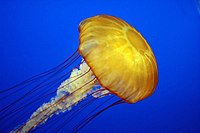
Photo from wikipedia
Significance Wirelessly controlled, multitasking soft devices active in aqueous environments are highly required for applications in microfluidics and organ-on-a-chip and as medical devices. Inspired by marine organisms, we present an… Click to show full abstract
Significance Wirelessly controlled, multitasking soft devices active in aqueous environments are highly required for applications in microfluidics and organ-on-a-chip and as medical devices. Inspired by marine organisms, we present an approach to achieve such devices by utilizing stimuli-responsive material assemblies capable of untethered object manipulation in an enclosed aqueous environment. Our soft robot assembly integrates a magnetically controlled stem with a light-responsive gripper with unmatched speed, insensitivity to contaminants, and high control of actuation underwater at low light intensities. The independent device segments can be orthogonally controlled to realize different tasks such as attracting, capturing, and releasing targets in an aqueous environment, demonstrating the significance of actuator assemblies in the fabrication of multifunctional soft devices operating underwater. The development of light-responsive materials has captured scientific attention and advanced the development of wirelessly driven terrestrial soft robots. Marine organisms trigger inspiration to expand the paradigm of untethered soft robotics into aqueous environments. However, this expansion toward aquatic soft robots is hampered by the slow response of most light-driven polymers to low light intensities and by the lack of controlled multishape deformations. Herein, we present a surface-anchored artificial aquatic coral polyp composed of a magnetically driven stem and a light-driven gripper. Through magnetically driven motion, the polyp induces stirring and attracts suspended targets. The light-responsive gripper is sensitive to low light intensities and has programmable states and rapid and highly controlled actuation, allowing the polyp to capture or release targets on demand. The artificial polyp demonstrates that assemblies of stimuli-responsive materials in water utilizing coordinated motion can perform tasks not possible for single-component devices.
Journal Title: Proceedings of the National Academy of Sciences of the United States of America
Year Published: 2020
Link to full text (if available)
Share on Social Media: Sign Up to like & get
recommendations!